Evaluating Residual Stress in Carbon Fiber-Reinforced Polymer (CFRP) at Microscale Using Fiber Push-Out Experiment and Finite Element Modeling
Abstract
1. Introduction
2. Methodology
3. Experimental Procedure
4. Finite Element Model
4.1. Mesh Generation
4.2. Analysis Steps
4.3. Material Models and Properties
5. Results and Discussion
5.1. FEMU Results and Application to Reproduce Matrix Sink-In
5.2. Evaluation of Residual Stress in Composite Using FE Modeling
5.3. Limitations and Potential Improvements
6. Concluding Remarks
Author Contributions
Funding
Institutional Review Board Statement
Data Availability Statement
Acknowledgments
Conflicts of Interest
Appendix A
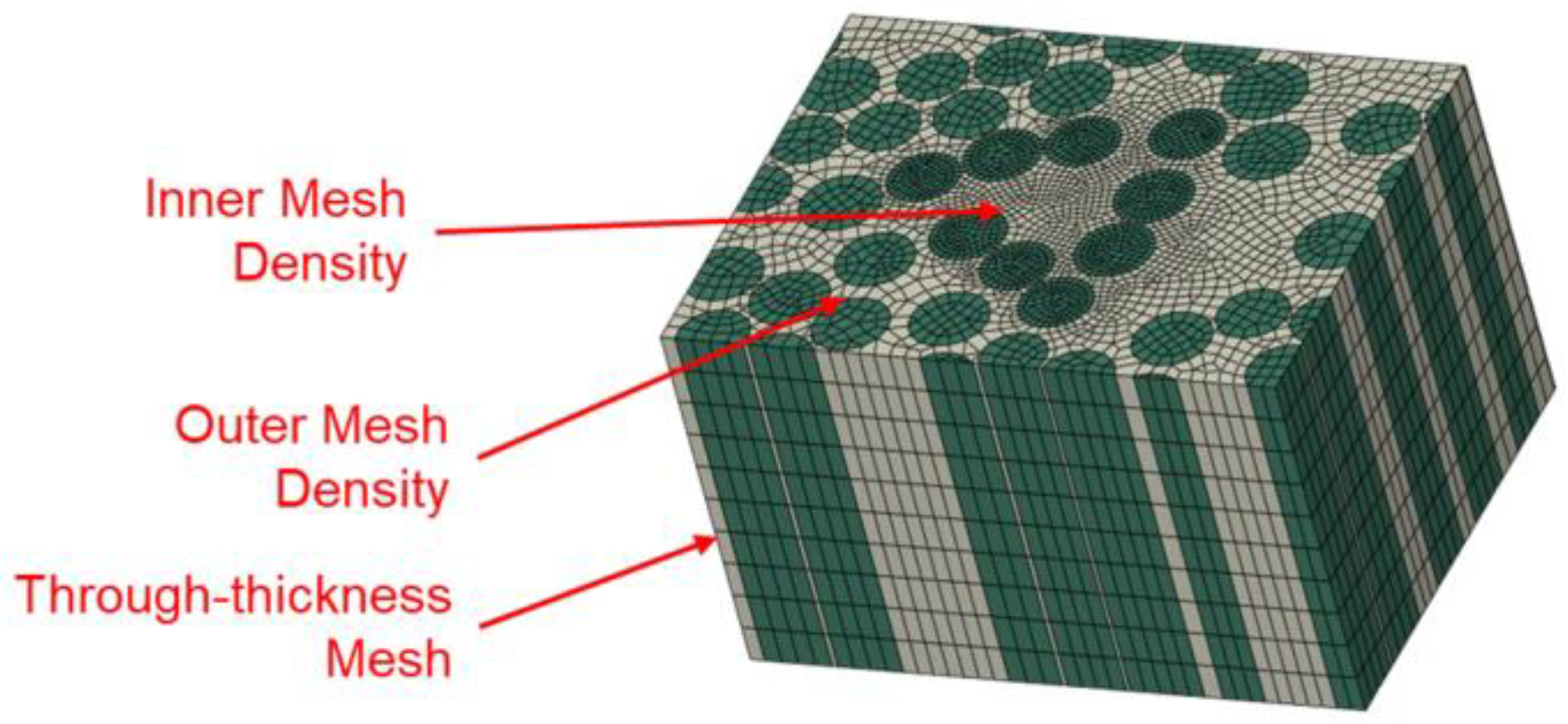



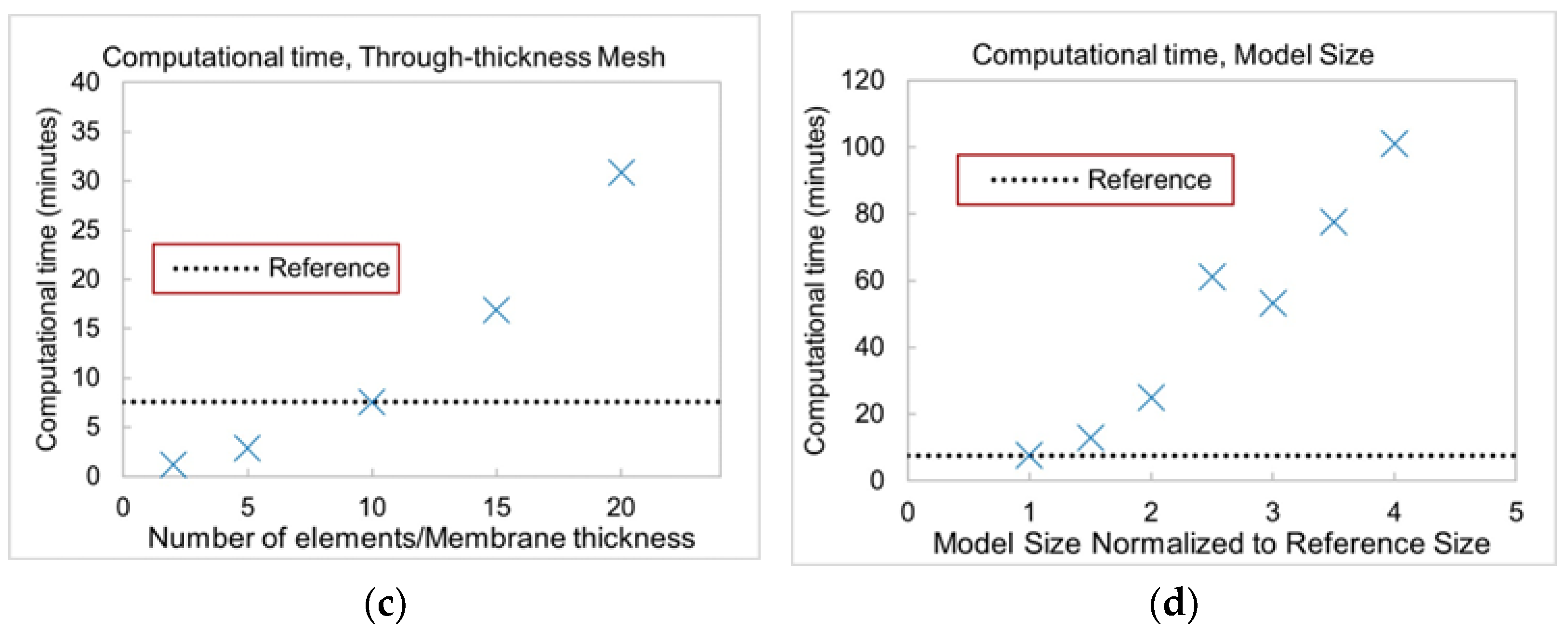
Appendix B
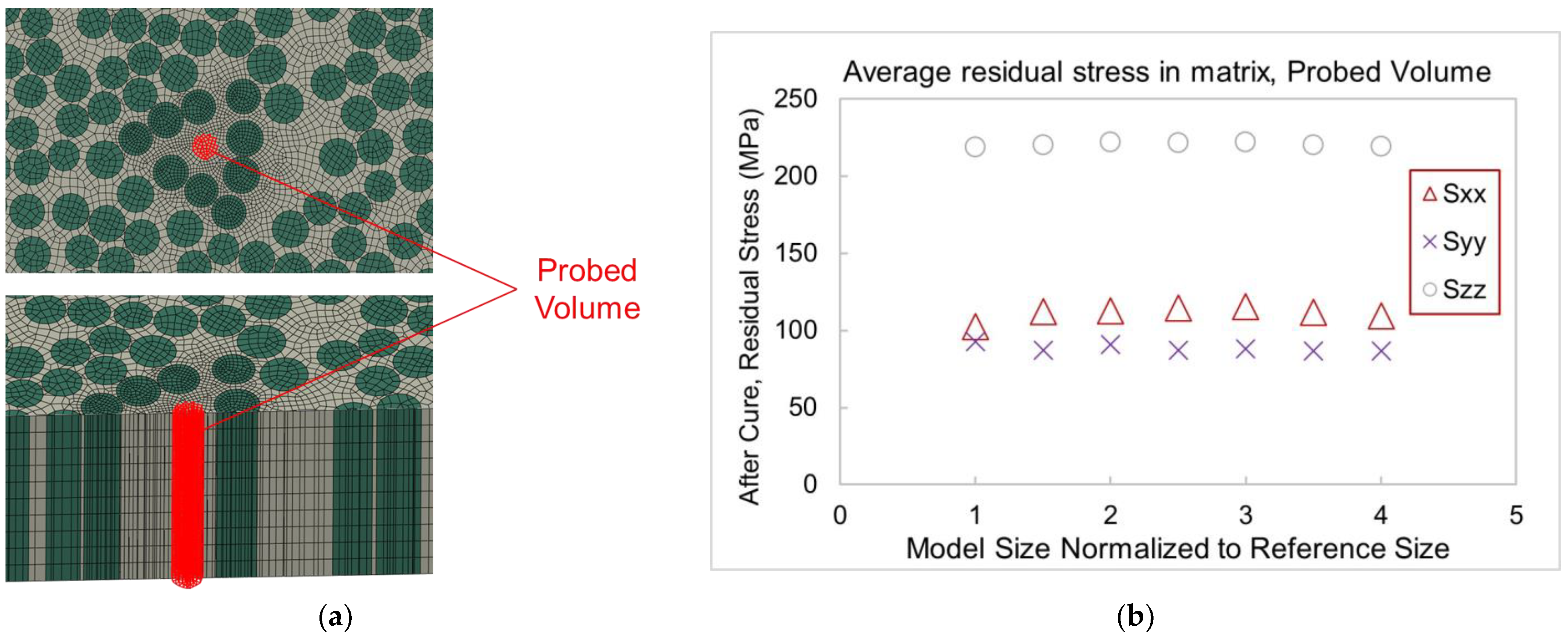
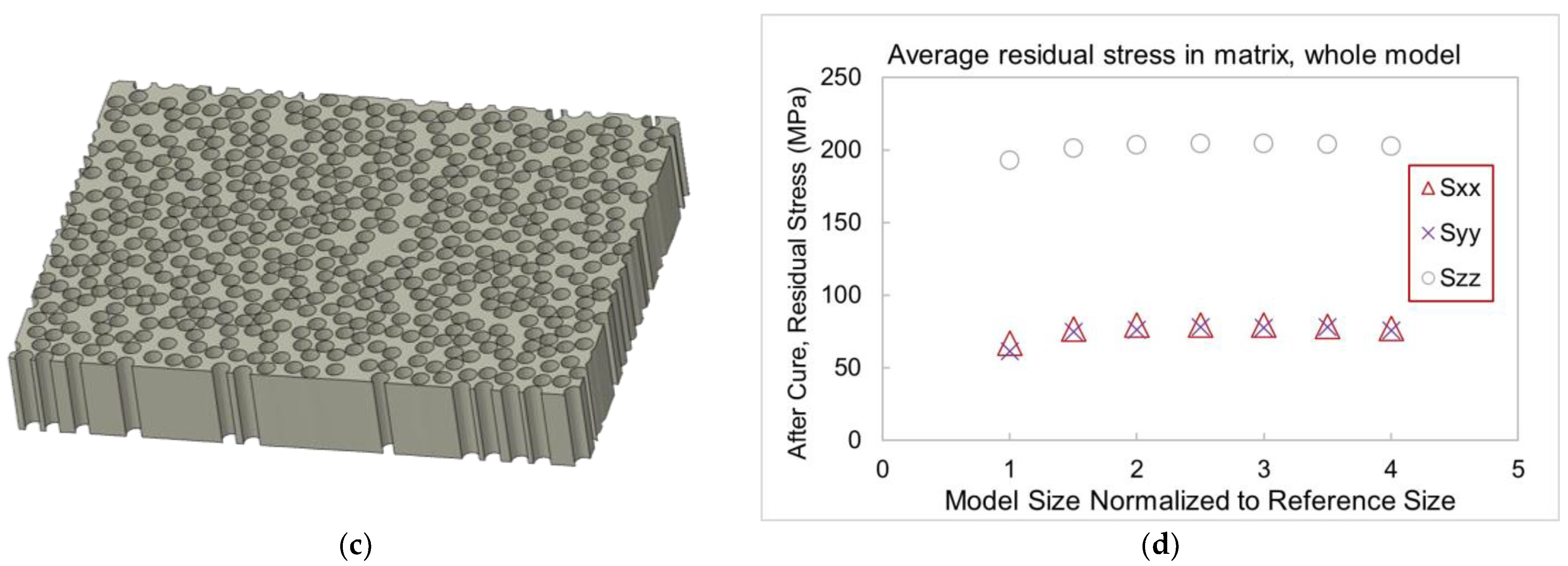

References
- Berg, J.S. Composite Material Advances in the Golf Industry. Europe 2000, 1, 7. [Google Scholar]
- Wang, J.L. Application of Composite Materials on Sports Equipments. AMM 2012, 155–156, 903–906. [Google Scholar] [CrossRef]
- Bechly, M.E.; Clausen, P.D. Structural Design of a Composite Wind Turbine Blade Using Finite Element Analysis. Comput. Struct. 1997, 63, 639–646. [Google Scholar] [CrossRef]
- Brøndsted, P.; Lilholt, H.; Lystrup, A. Composite Materials for Wind Power Turbine Blades. Annu. Rev. Mater. Res. 2005, 35, 505–538. [Google Scholar] [CrossRef]
- Beardmore, P.; Johnson, C.F. The Potential for Composites in Structural Automotive Applications. Compos. Sci. Technol. 1986, 26, 251–281. [Google Scholar] [CrossRef]
- Ravishankar, B.; Nayak, S.K.; Kader, M.A. Hybrid Composites for Automotive Applications—A Review. J. Reinf. Plast. Compos. 2019, 38, 835–845. [Google Scholar] [CrossRef]
- Dow, N.F.; Rosen, B.W. Evaluations of Filament-Reinforced Composites for Aerospace Structural Applications; General Electric Co.: Philadelphia, PA, USA, 1965. [Google Scholar]
- Steinberg, M.A. Materials for Aerospace. Sci. Am. 1986, 255, 66–73. [Google Scholar] [CrossRef]
- Quilter, A. Composites in Aerospace Applications. IHS White Pap. 2001, 444, 264. [Google Scholar]
- McIlhagger, A.; Archer, E.; McIlhagger, R. Manufacturing Processes for Composite Materials and Components for Aerospace Applications. In Polymer Composites in the Aerospace Industry; Elsevier: Amsterdam, The Netherlands, 2020; pp. 59–81. [Google Scholar]
- Ehsani, M.R.; Saadatmanesh, H. Fiber Composite Plates for Strengthening Bridge Beams. Compos. Struct. 1990, 15, 343–355. [Google Scholar] [CrossRef]
- Rosner, C.N.; Rizkalla, S.H. Bolted Connections for Fiber-Reinforced Composite Structural Members: Experimental Program. J. Mater. Civ. Eng. 1995, 7, 223–231. [Google Scholar] [CrossRef]
- Noël, M. Probabilistic Fatigue Life Modelling of FRP Composites for Construction. Constr. Build. Mater. 2019, 206, 279–286. [Google Scholar] [CrossRef]
- Xian, G.; Guo, R.; Li, C.; Hong, B. Mechanical Properties of Carbon/Glass Fiber Reinforced Polymer Plates with Sandwich Structure Exposed to Freezing-Thawing Environment: Effects of Water Immersion, Bending Loading and Fiber Hybrid Mode. Mech. Adv. Mater. Struct. 2023, 30, 814–834. [Google Scholar] [CrossRef]
- Guo, R.; Li, C.; Xian, G. Water Absorption and Long-Term Thermal and Mechanical Properties of Carbon/Glass Hybrid Rod for Bridge Cable. Eng. Struct. 2023, 274, 115176. [Google Scholar] [CrossRef]
- Totry, E.; Molina-Aldareguía, J.M.; González, C.; LLorca, J. Effect of Fiber, Matrix and Interface Properties on the in-Plane Shear Deformation of Carbon-Fiber Reinforced Composites. Compos. Sci. Technol. 2010, 70, 970–980. [Google Scholar] [CrossRef]
- Bai, X.; Bessa, M.A.; Melro, A.R.; Camanho, P.P.; Guo, L.; Liu, W.K. High-Fidelity Micro-Scale Modeling of the Thermo-Visco-Plastic Behavior of Carbon Fiber Polymer Matrix Composites. Compos. Struct. 2015, 134, 132–141. [Google Scholar] [CrossRef]
- Sun, Q.; Meng, Z.; Zhou, G.; Lin, S.-P.; Kang, H.; Keten, S.; Guo, H.; Su, X. Multi-Scale Computational Analysis of Unidirectional Carbon Fiber Reinforced Polymer Composites under Various Loading Conditions. Compos. Struct. 2018, 196, 30–43. [Google Scholar] [CrossRef]
- Ghaffari, S.; Makeev, A.; Kuksenko, D.; Seon, G. Understanding High-Modulus CFRP Compressive Strength Improvement. In Proceedings of the American Society for Composites Thirty-Fourth Technical Conference, Atlanta, GA, USA, 23–25 September 2019. [Google Scholar]
- Ghaffari, S.; Seon, G.; Makeev, A.; Iarve, E.; Mollenhauer, D. Microstructural Methods for Developing High-Performance Composite Materials. In Proceedings of the AIAA Scitech Conference, Orlando, FL, USA, 6–10 January 2020. [Google Scholar]
- Sharma, A.; Daggumati, S.; Gupta, A.; Van Paepegem, W. On the Prediction of the Bi-Axial Failure Envelope of a UD CFRP Composite Lamina Using Computational Micromechanics: Effect of Microscale Parameters on Macroscale Stress–Strain Behavior. Compos. Struct. 2020, 251, 112605. [Google Scholar] [CrossRef]
- Jiang, H.; Ren, Y.; Liu, Z.; Zhang, S. Microscale Finite Element Analysis for Predicting Effects of Air Voids on Mechanical Properties of Single Fiber Bundle in Composites. J. Mater. Sci. 2019, 54, 1363–1381. [Google Scholar] [CrossRef]
- Zhou, W.; Zhu, W.; Xu, Q.; Ke, Y. Out-of-Plane Tensile Failure Behavior of Fiber Reinforced Composites Due to Lay-up Temperature Induced Intra-Ply and Inter-Ply Voids. Compos. Struct. 2021, 271, 114150. [Google Scholar] [CrossRef]
- Jäger, J.; Sause, M.G.R.; Burkert, F.; Moosburger-Will, J.; Greisel, M.; Horn, S. Influence of Plastic Deformation on Single-Fiber Push-out Tests of Carbon Fiber Reinforced Epoxy Resin. Compos. Part A 2015, 71, 157–167. [Google Scholar] [CrossRef]
- Ghaffari, S.; Seon, G.; Makeev, A. In-Situ SEM Based Method for Assessing Fiber-Matrix Interface Shear Strength in CFRPs. Mater. Des. 2021, 197, 109242. [Google Scholar] [CrossRef]
- Rohrmüller, B.; Gumbsch, P.; Hohe, J. Calibrating a Fiber–Matrix Interface Failure Model to Single Fiber Push-out Tests and Numerical Simulations. Compos. Part A 2021, 150, 106607. [Google Scholar] [CrossRef]
- Shah, D.U.; Schubel, P.J. Evaluation of Cure Shrinkage Measurement Techniques for Thermosetting Resins. Polym. Test. 2010, 29, 629–639. [Google Scholar] [CrossRef]
- Khoun, L.; Hubert, P. Cure Shrinkage Characterization of an Epoxy Resin System by Two in Situ Measurement Methods. Polym. Compos. 2010, 31, 1603–1610. [Google Scholar] [CrossRef]
- Nawab, Y.; Shahid, S.; Boyard, N.; Jacquemin, F. Review: Chemical Shrinkage Characterization Techniques for Thermoset Resins and Associated Composites. J. Mater. Sci. 2013, 48, 5387–5409. [Google Scholar] [CrossRef]
- Huang, X. Fabrication and Properties of Carbon Fibers. Materials 2009, 2, 2369–2403. [Google Scholar] [CrossRef]
- Zhao, L.G.; Warrior, N.A.; Long, A.C. A Micromechanical Study of Residual Stress and Its Effect on Transverse Failure in Polymer–Matrix Composites. Int. J. Solids Struct. 2006, 43, 5449–5467. [Google Scholar] [CrossRef]
- Agius, S.L.; Joosten, M.; Trippit, B.; Wang, C.H.; Hilditch, T. Rapidly Cured Epoxy/Anhydride Composites: Effect of Residual Stress on Laminate Shear Strength. Compos. Part A 2016, 90, 125–136. [Google Scholar] [CrossRef]
- Naya, F.; Gonzalez, C.; Lopes, C.S.; Van der Veen, S.; Pons, F. Computational Micromechanics of the Transverse and Shear Behavior of Unidirectional Fiber Reinforced Polymers Including Environmental Effects. Compos. Part A 2017, 92, 146–157. [Google Scholar] [CrossRef]
- Naya, F.; Herraez, M.; Lopes, C.S.; Gonzalez, C.; Van der Veen, S.; Pons, F. Computational Micromechanics of Fiber Kinking in Unidirectional FRP under Different Environmental Conditions. Compos. Sci. Technol. 2017, 144, 26–35. [Google Scholar] [CrossRef]
- Maiaru, M.; D’Mello, R.J.; Waas, A.M. Characterization of Intralaminar Strengths of Virtually Cured Polymer Matrix Composites. Compos. Part B 2018, 149, 285–295. [Google Scholar] [CrossRef]
- Seers, B.; Tomlinson, R.; Fairclough, P. Residual Stress in Fiber Reinforced Thermosetting Composites: A Review of Measurement Techniques. Polym. Compos. 2021, 42, 1631–1647. [Google Scholar] [CrossRef]
- Kao, C.; Young, R.J. Assessment of Interface Damage during the Deformation of Carbon Nanotube Composites. J. Mater. Sci. 2010, 45, 1425–1431. [Google Scholar] [CrossRef]
- Jannotti, P.; Subhash, G.; Zheng, J.; Halls, V. Measurement of Microscale Residual Stresses in Multi-Phase Ceramic Composites Using Raman Spectroscopy. Acta Mater. 2017, 129, 482–491. [Google Scholar] [CrossRef]
- Kollins, K.; Przybyla, C.; Amer, M.S. Residual Stress Measurements in Melt Infiltrated SiC/SiC Ceramic Matrix Composites Using Raman Spectroscopy. J. Eur. Ceram. Soc. 2018, 38, 2784–2791. [Google Scholar] [CrossRef]
- Nance, J.; Subhash, G.; Sankar, B.; Haftka, R.; Kim, N.H.; Deck, C.; Oswald, S. Measurement of Residual Stress in Silicon Carbide Fibers of Tubular Composites Using Raman Spectroscopy. Acta Mater. 2021, 217, 117164. [Google Scholar] [CrossRef]
- Tallant, D.R.; Friedmann, T.A.; Missert, N.A.; Siegal, M.P.; Sullivan, J.P. Raman Spectroscopy of Amorphous Carbon; Sandia National Laboratories: Albuquerque, NM, USA, 1997; Volume 498, pp. 37–48. [Google Scholar]
- Boukenter, A.; Duval, E.; Rosenberg, H.M. Raman Scattering in Amorphous and Crystalline Materials: A Study of Epoxy Resin and DGEBA. J. Phys. C Solid State Phys. 1998, 21, 541–547. [Google Scholar] [CrossRef]
- Tuschel, D. Why Are the Raman Spectra of Crystalline and Amorphous Solids Different? Spectroscopy 2017, 32, 26–33. [Google Scholar]
- Pick, M.; Lovell, R.; Windle, A.H. Detection of Elastic Strain in an Amorphous Polymer by X-ray Scattering. Nature 1979, 281, 658–659. [Google Scholar] [CrossRef]
- Predecki, P.; Barrett, C.S. Stress Measurement in Graphite/Epoxy Composites by X-ray Diffraction from Fillers. J. Compos. Mater. 1979, 13, 61–71. [Google Scholar] [CrossRef]
- Predecki, P.; Barrett, C.S. Detection of Moisture in Graphite/Epoxy Laminates by X-ray Diffraction. J. Compos. Mater. 1982, 16, 260–267. [Google Scholar] [CrossRef]
- Kamal, M.R.; Sourour, S. Kinetics and Thermal Characterization of Thermoset Cure. Polym. Eng. Sci. 1973, 13, 59–64. [Google Scholar] [CrossRef]
- Li, Q.; Li, X.; Meng, Y. Curing of DGEBA Epoxy Using a Phenol-Terminated Hyperbranched Curing Agent: Cure Kinetics, Gelation, and the TTT Cure Diagram. Thermochim. Acta 2012, 549, 69–80. [Google Scholar] [CrossRef]
- Schechter, S.G.K.; Grunenfelder, L.K.; Nutt, S.R. Air Evacuation and Resin Impregnation in Semipregs: Effects of Feature Dimensions. Adv. Manuf. Polym. Compos. Sci. 2020, 6, 101–114. [Google Scholar] [CrossRef]
- Rabearison, N.; Jochum, C.; Grandidier, J.C. A FEM Coupling Model for Properties Prediction during the Curing of an Epoxy Matrix. Comput. Mater. Sci. 2009, 45, 715–724. [Google Scholar] [CrossRef]
- HEXCEL HexPly 8552 Datasheet. Available online: https://www.hexcel.com/user_area/content_media/raw/HexPly_8552_us_DataSheet.pdf (accessed on 3 March 2023).
- Grafil Inc. PYROFILTM HS40 12K. Available online: https://www.rockwestcomposites.com/downloads/HS40-12K_(07-2008).pdf (accessed on 3 March 2023).
- Ghaffari, S.; Seon, G.; Makeev, A. Effect of Fiber–Matrix Interface Friction on Compressive Strength of High-Modulus Carbon Composites. Molecules 2023, 28, 2049. [Google Scholar] [CrossRef] [PubMed]


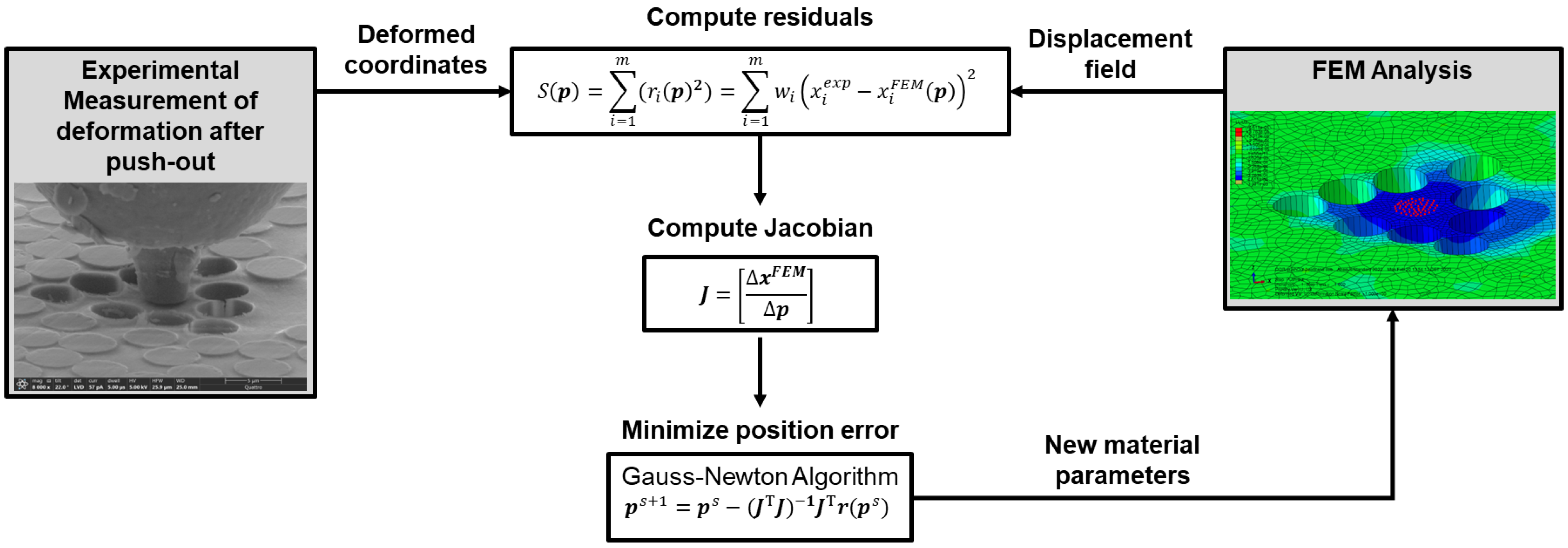
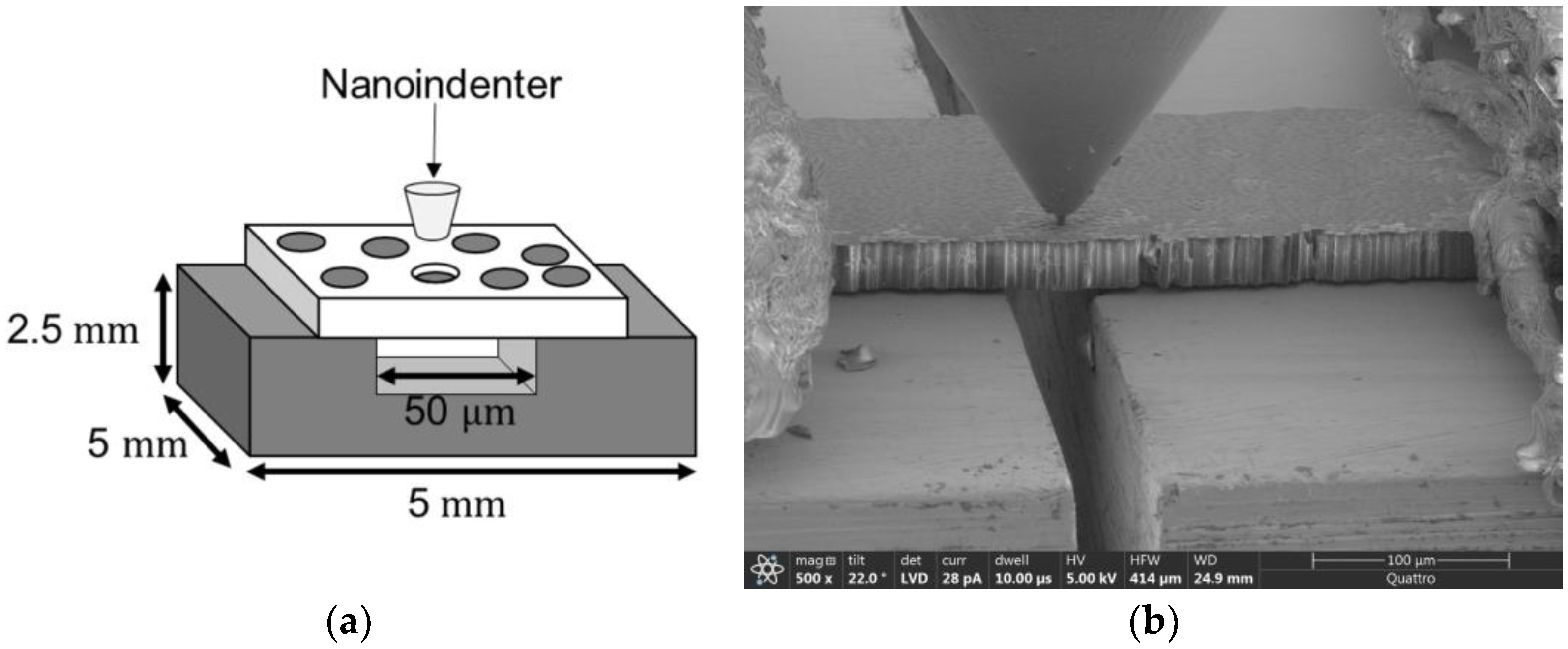
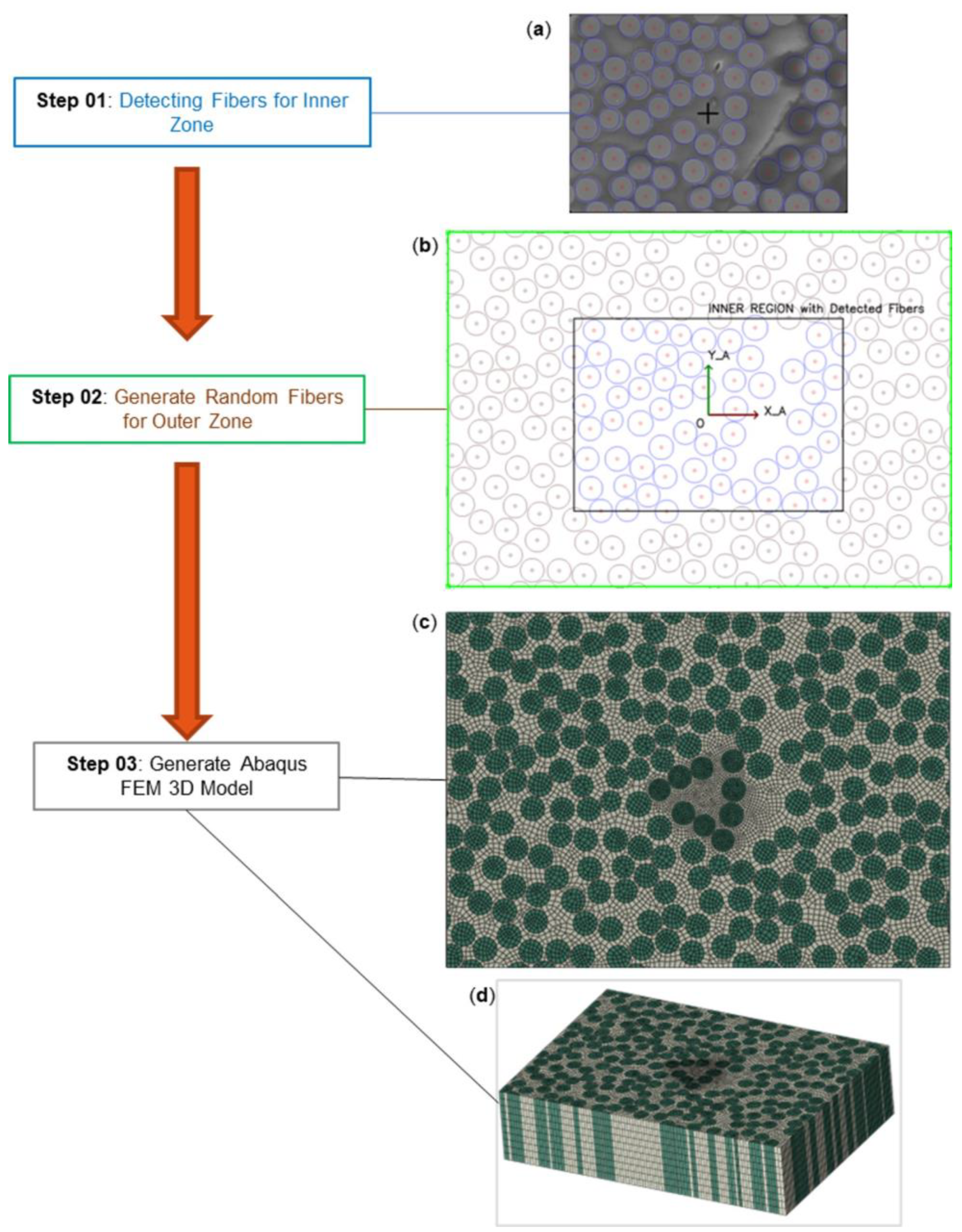

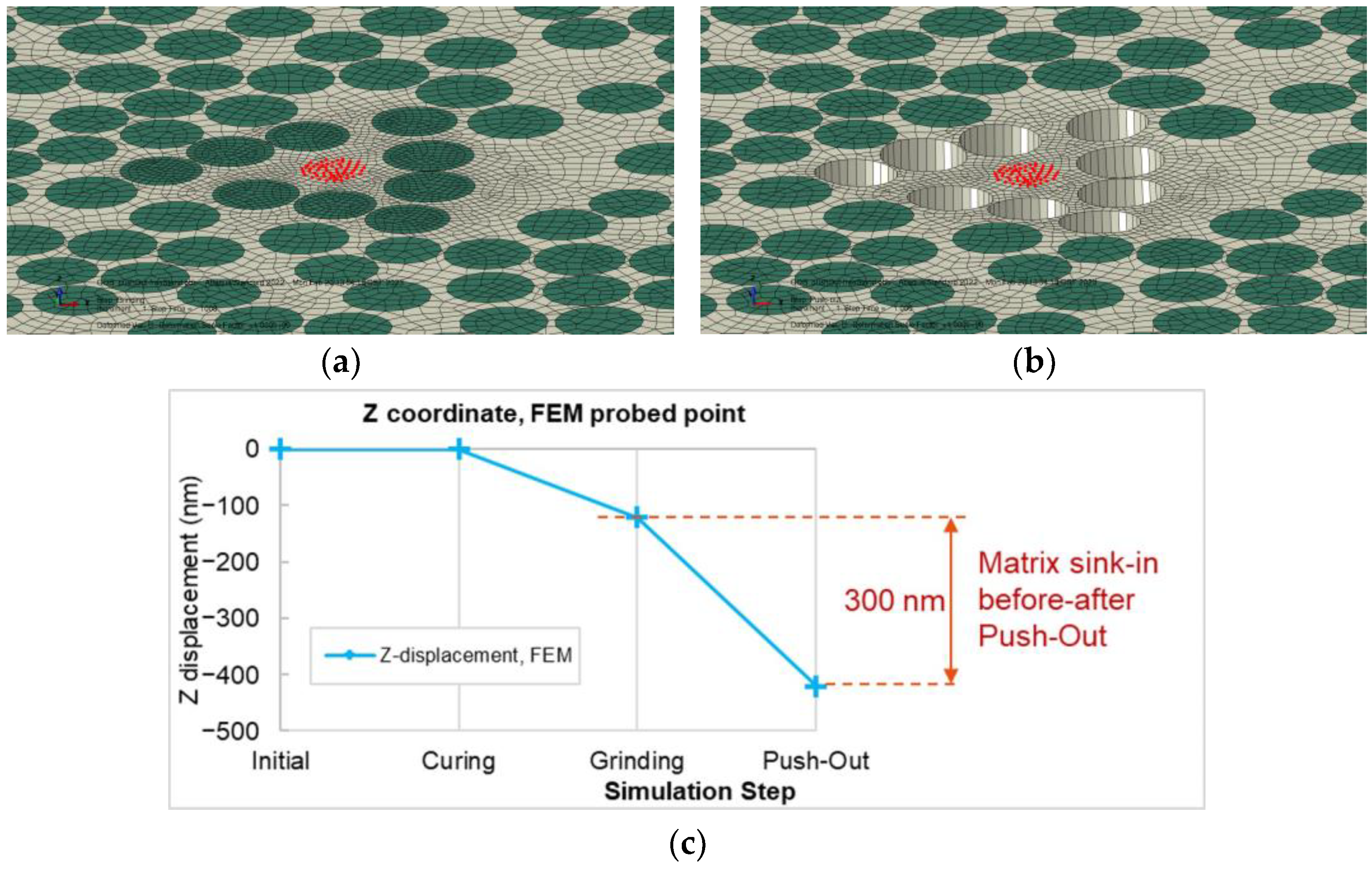
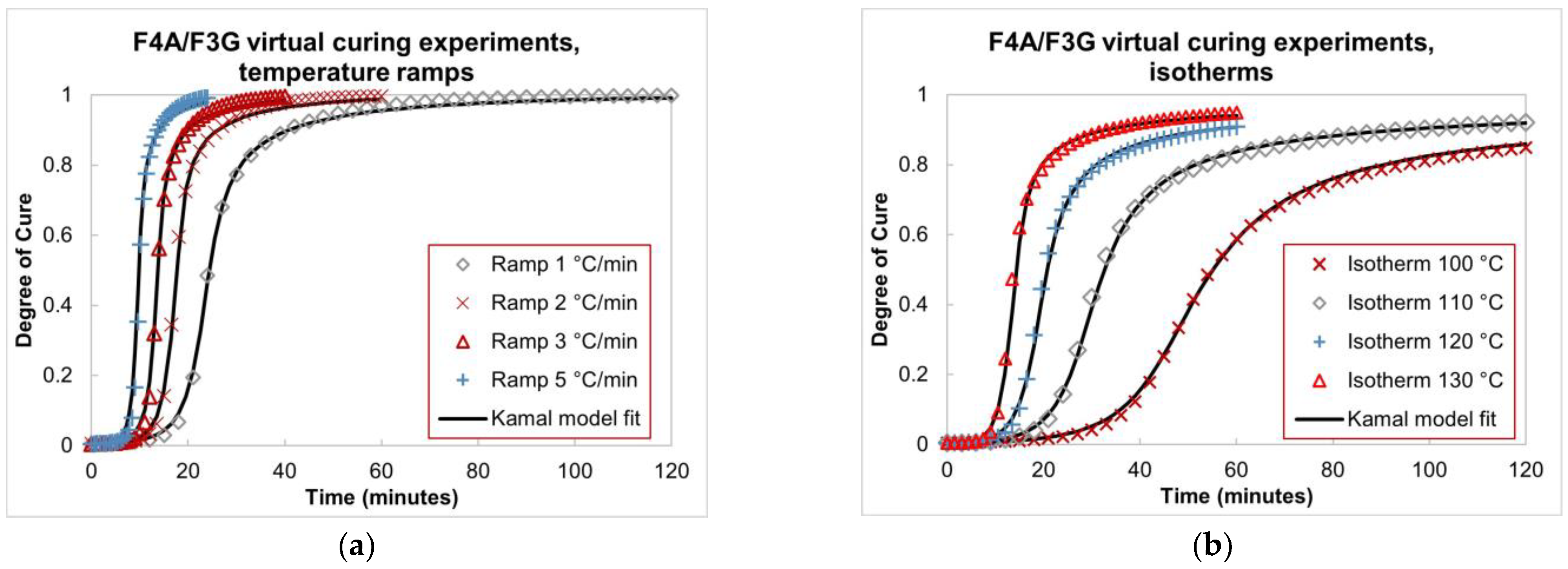


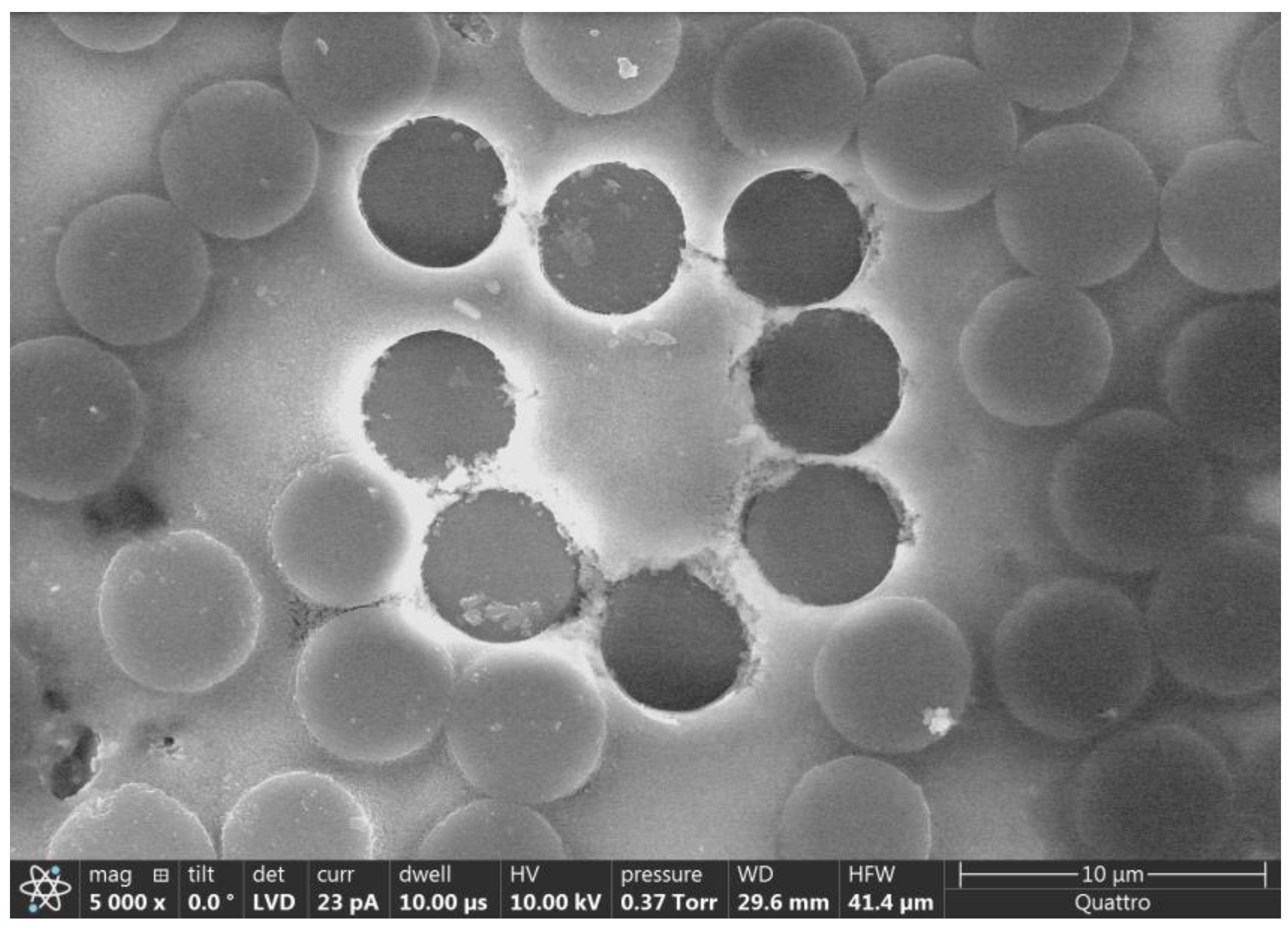

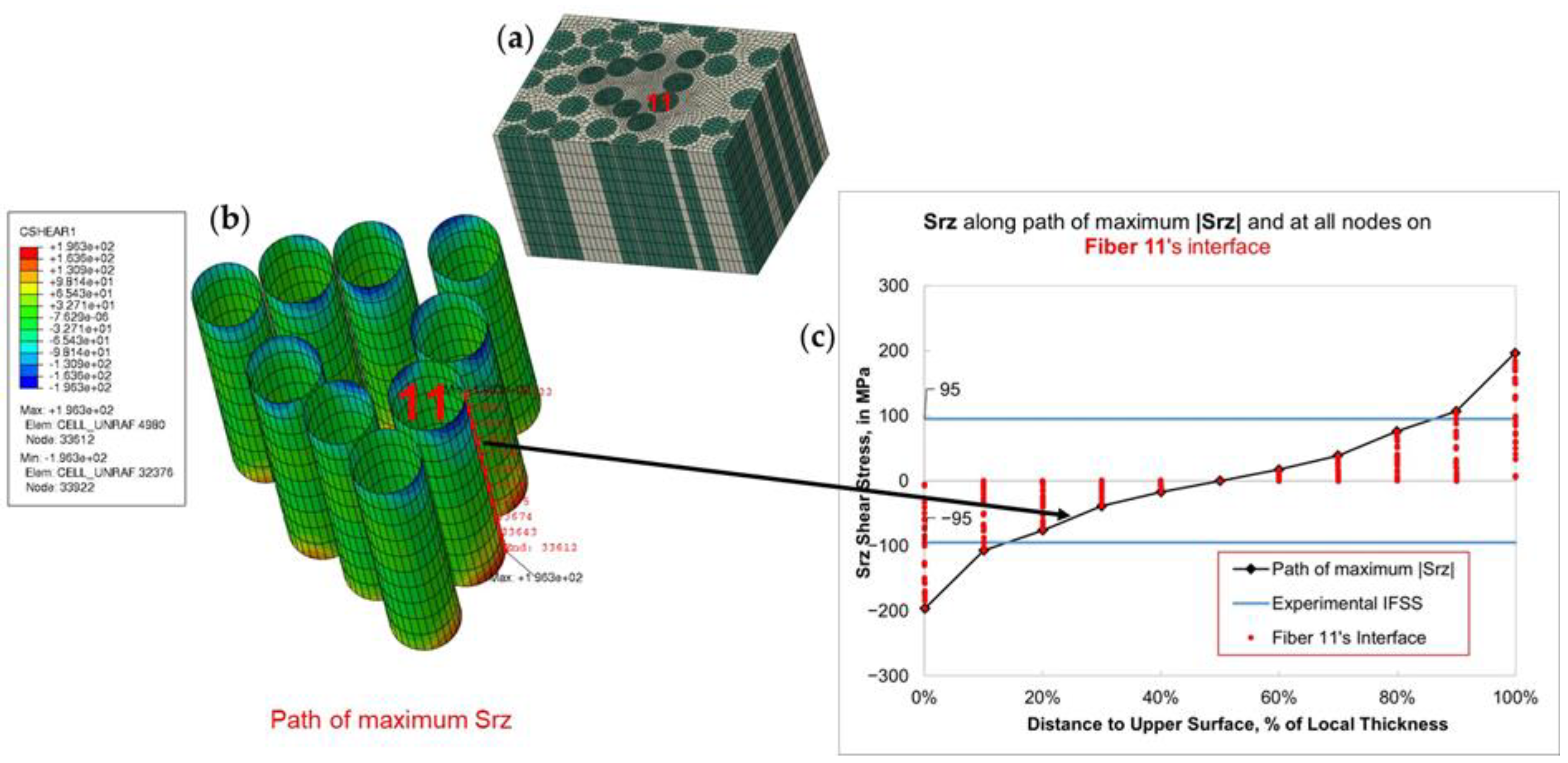

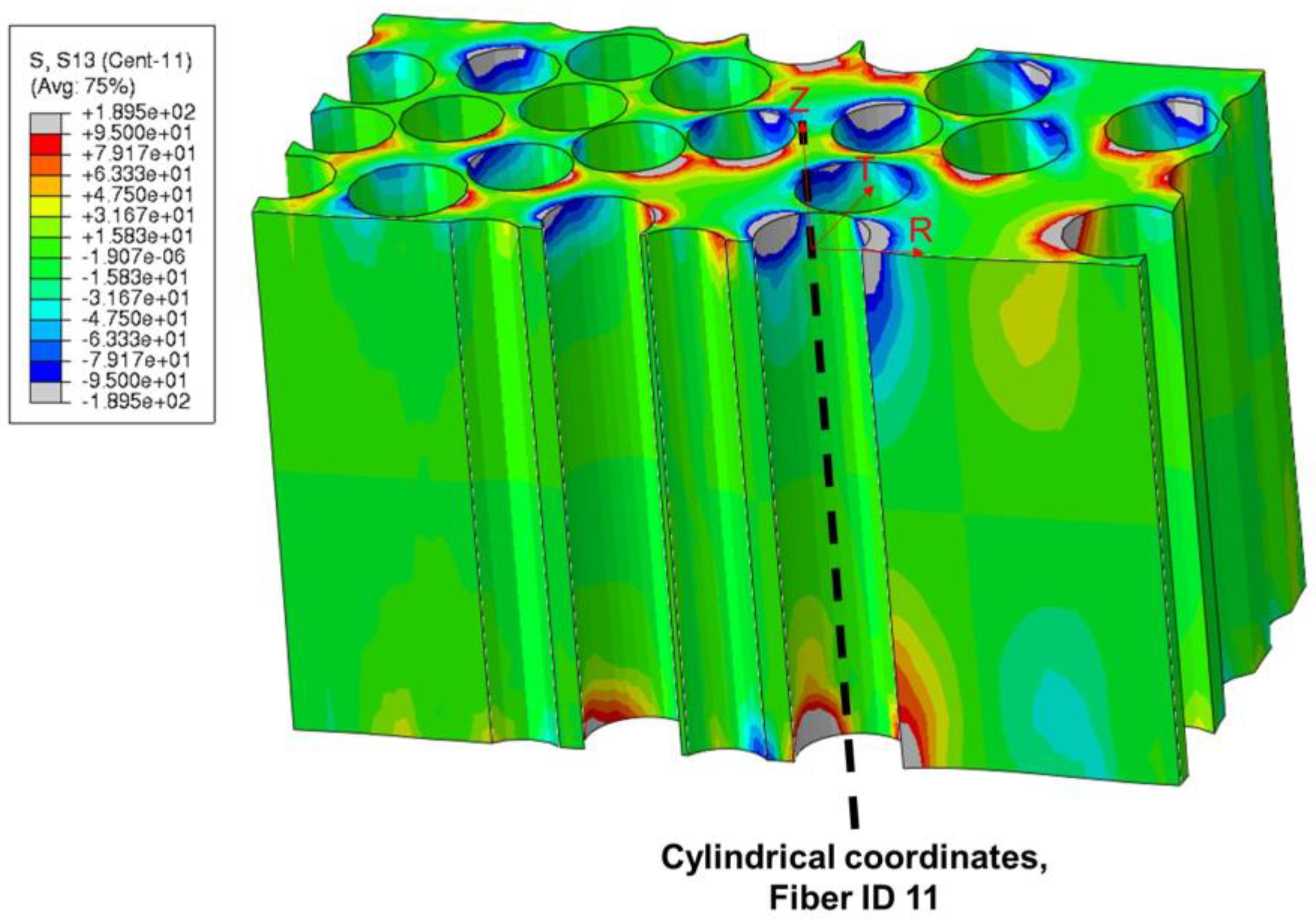
| Kinetics Parameter | Value | Unit |
|---|---|---|
| - | ||
| - | ||
| Elasticity | ||
| Thermal properties | ||
| Curing properties | ||
| Elasticity | |||||||||
| Thermal properties | |||||||||
| Test Area | Experimental Sink-In | Chemical Shrinkage (, 100% DOC) |
|---|---|---|
| Sample 3 Area 4 | 360 | 4.91% |
| Sample 3 Area 2 | 328 | 4.10% |
| Sample 3 Area 1 | 319 | 3.68% |
| Sample 4 Area 2 | 260 | 3.24% |
| Sample 4 Area 1 | 300 | 3.43% |
| Mean | 3.87% | |
| Standard Deviation | 0.66% | |
| Coefficient of Variation | 17.1% |
| Test Area | Visible Matrix Damage? | FEM-Predicted Sink-In (nm) | Experimental Sink-In (nm) | Difference |
|---|---|---|---|---|
| Sample 5, Area 1 | Yes | 257 | 530 | 106% |
| Sample 5, Area 2 | No | 258 | 144 | −44% |
| Sample 5, Area 3 | No | 178 | 131 | −26% |
| Sample 2, Area 3 | No | 299 | 351 | 17% |
| Sample 2, Area 4, p1 | Yes | 120 | 390 | 225% |
| Sample 2, Area 4, p2 | Yes | 152 | 340 | 124% |
| Sample 2, Area 5 | Yes | 62 | 345 | 456% |
Disclaimer/Publisher’s Note: The statements, opinions and data contained in all publications are solely those of the individual author(s) and contributor(s) and not of MDPI and/or the editor(s). MDPI and/or the editor(s) disclaim responsibility for any injury to people or property resulting from any ideas, methods, instructions or products referred to in the content. |
© 2023 by the authors. Licensee MDPI, Basel, Switzerland. This article is an open access article distributed under the terms and conditions of the Creative Commons Attribution (CC BY) license (https://creativecommons.org/licenses/by/4.0/).
Share and Cite
Vu, Q.T.L.; Seon, G.; Ghaffari, S.; Makeev, A.; Lachaud, F.; Charlotte, M.; Gourinat, Y. Evaluating Residual Stress in Carbon Fiber-Reinforced Polymer (CFRP) at Microscale Using Fiber Push-Out Experiment and Finite Element Modeling. Polymers 2023, 15, 2596. https://doi.org/10.3390/polym15122596
Vu QTL, Seon G, Ghaffari S, Makeev A, Lachaud F, Charlotte M, Gourinat Y. Evaluating Residual Stress in Carbon Fiber-Reinforced Polymer (CFRP) at Microscale Using Fiber Push-Out Experiment and Finite Element Modeling. Polymers. 2023; 15(12):2596. https://doi.org/10.3390/polym15122596
Chicago/Turabian StyleVu, Quy Tung Linh, Guillaume Seon, Sarvenaz Ghaffari, Andrew Makeev, Frédéric Lachaud, Miguel Charlotte, and Yves Gourinat. 2023. "Evaluating Residual Stress in Carbon Fiber-Reinforced Polymer (CFRP) at Microscale Using Fiber Push-Out Experiment and Finite Element Modeling" Polymers 15, no. 12: 2596. https://doi.org/10.3390/polym15122596
APA StyleVu, Q. T. L., Seon, G., Ghaffari, S., Makeev, A., Lachaud, F., Charlotte, M., & Gourinat, Y. (2023). Evaluating Residual Stress in Carbon Fiber-Reinforced Polymer (CFRP) at Microscale Using Fiber Push-Out Experiment and Finite Element Modeling. Polymers, 15(12), 2596. https://doi.org/10.3390/polym15122596






